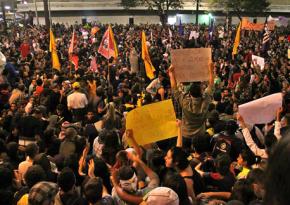Private transit, public protest
The protests in Brazil that began in opposition to transit fare hikes have sparked a mass movement seeking change far beyond what first animated it. The proposed fare increases were relatively modest, but anger at this injustice tapped into a well of resentment. In this article, Canadian socialist and union activist writes from São Paulo on how the volatile issue of transportation became a flash point for a much wider set of grievances.
SÃO PAULO has some of the worst traffic in the world. Workers' daily commutes can be over two hours--one way--without ever leaving the city. Rain or traffic accidents can easily increase a commute to over four hours. Streets become so congested during peak hours of traffic that the local news stations report on the length of kilometers of stopped cars and trucks on the highways entering the city. There are permanent signs mounted beside these highways, with lights that can be turned on and off, indicating that "traffic is stopped in front."
São Paulo has the highest per capita density of private helicopters in the world. Those with serious money in this extremely rich and unequal city choose the option to literally fly over the traffic jams.
People traffic can be equally awful. Despite an extensive underground subway and many bus lines (with 60 kilometers of dedicated lanes; diesel, biodiesel and electrified buses; double- and even triple-length articulated buses) in São Paulo, buses and subways fill to the point of internal pressure. Lines to board the subway can be as long as two hours while buses that are filled beyond capacity roar past lines of passengers waiting at the bus stop.

The buses in São Paulo are painted with different color schemes. The various colors seem like they are designed to help distinguish one bus line from another or bus lines in different parts of the city from each other. In a city the size of São Paulo (with a population of almost 20 million people), this would help.
The colors of the buses are indeed designed to make them distinguishable from others, but the main purpose is to indicate the brand of the bus line. There is no "public" transit system. There is "collective transport" because it's run by private, for-profit companies that combine to maintain oligopolistic control over the "market" for transport routes.
Critics refer to the companies collectively as a cartel. The system was thoroughly privatized throughout Brazil by Fernando Henrique Cardoso, a former leftist who preceded Luiz Inácio Lula da Silva as president of Brazil.
THE CURRENT explosion of protest was sparked by an increase in transit fares from $1.33 to $1.42 (or more) in cities throughout Brazil.
Fares are controlled at the municipal level and are a result of intense negotiations with the private companies. Despite the decentralized nature of the negotiations, fares are typically raised in similar proportions in coordinated fashion, once per year. More than 100 cities have seen a consistently growing number of people taking over streets, highways and even the airports of São Paulo. The brutal and violent response of the military police has provoked a wider group to leave their houses and workplaces to join the demonstrations.
One of the key organizers of the demonstrations has been the Movimento Passe Livre (MPL) or "Free Pass Movement." They originally demanded an immediate revocation of the fare increase. The MPL describes itself as a Brazilian social movement fighting for a genuinely public transportation system--that is, a system that has universal access and brings the system back into the public sector.
It is similar to movements in Toronto and other cities that use community organizing and demonstrations as tactics to build support and awareness of the crucial role of public transit. They do not contest political power, and they maintain a decentralized, network-organizing model.
According to the MPL, organizers started to build the current iteration of the movement for public and universal transit in Salvador in the northeast of the country in 2003. Salvador is the state capital of Bahia. Life in Salvador was seriously disrupted with some streets paralyzed for 10 days due to demonstrations that followed a 2003 increase in transit fares.
The following year, another increase in fares led to similar demonstrations and organizing in Fortaleza, another capital in the northeast of Brazil. Organizers from these two cities met at the Fifth World Social Forum in Porto Alegre and initiated the MPL. The movement has grown and spread to cities throughout Brazil.
After five days of increasingly intense and disruptive demonstrations, four large and important cities revoked the fare increases. After six days of disruption, both São Paulo and Rio de Janeiro also returned fares to their previous levels.
While the governor of the state of São Paulo threatened that the reduction in fares would lead to a "cut in investments in transit infrastructure" as a consequence, this seemed like the victory the movement had been building toward. But the demonstrations continued to build and strengthen, and the next day, the streets once again filled with people. People again took over their city streets throughout the country, this time adding, "This was never just about 12 cents!" to the chants.
Somewhat inexplicably for organizers and certainly for the media, the action in the streets was growing and diversifying quickly. The majority of the people massing are young, middle class and mostly white. The constellation of people in the streets differs by city and is changing every day, but this has largely been the picture throughout the country for the first two weeks of protests. What started as anger at rising public transit fares has morphed into demands for more public education, health care and security and an end to the extensive, systemic corruption that pervades the political system.
SEVERAL CRITICAL variables have fortuitously combined to fuel the movement of people into the streets. First, a constitutional amendment that would severely constrain the ability to criminally charge and prosecute politicians (known as PEC 37) is currently being debated. Many in the streets are calling it a form of immunity for politicians and are outraged at the prospect.
Second, the federal government (under the leadership of the Partido dos Trabalhadores (PT), or Workers' Party) recently created a permanent commission for human rights. As a concession to opposition politicians, they were forced to allow a right-wing homophobic politician named Marco Filiciano (PSC-SP) as its chair.
The first large initiative launched by Filiciano has been to establish a system of (self-referral) psychological assessments and consultations for gay people or people who think they might be gay. It's referred to as the "gay cure" in the streets. The proposal has been met with strong resistance and outright disgust in São Paulo--the city with the largest Gay Pride parade in the world--as well as the rest of Brazil. Signs in the streets read, "Filiciano, we haven't forgotten about you, your turn is coming, we can only deal with one shit at a time."
Additionally and coincidentally, the Confederations Cup soccer tournament--which is considered a warm-up for next year's World Cup that will also take place in Brazil--is currently happening in the recently rebuilt and renovated stadiums throughout the country.
Renovations and new construction have cost billions. Demonstrations have strategically and systematically focused on the huge investments in soccer stadiums in contrast to the basic unmet needs of Brazilians in terms of public health, education and infrastructure. For example, Natal--the site of the brand new Arena das Dunas, which cost roughly $177 million--doesn't have a basic municipal sanitation system. Brand new buildings in the local sports complex were knocked to the ground to make way for the new stadium.
Demonstrations have targeted some of these stadiums during the current Confederations Cup, but military police have used every available tactic in their arsenal to keep demonstrations far from the stadiums. The numbers in the streets have at times exceeded the numbers inside the stadiums. Interestingly, organized groups of soccer fans (known as torcedores in Portuguese) for the national first division clubs in São Paulo have joined forces to mobilize their members into the streets for demonstrations. They issued a joint call appealing to their members "to fill the streets as if we had won the championship."
FIFA head Sett Blatter dismissed the demonstrators as opportunists while Aldo Rebelo, federal minister of sport, sat beside Blatter at a press conference and proclaimed that demonstrations during the world cup would not be allowed to occur, a commitment that will surely be impossible to fulfill.
TRADE UNIONS and their national labor federation (known by its Portuguese acronym CUT) have been almost invisible during the street protests.
This is largely because the protest movement has declared itself to be unambiguously and aggressively "anti-party," and trade unions are closely associated with the PT. In one instance, demonstrators surrounded a group of trade unionists, took their flags, ripped them up and burned them. Several have been beaten. Just minutes later, the demonstrators surrounded a young man collecting palm leaves to use as fuel for a fire while chanting "sem violencia, sem vandalismo (no violence, no vandalism)!" Various firsthand reports suggest that organized right-wing groups were behind such assaults in São Paulo and Rio de Janeiro.
Chants against the PT generally as well as against particular PT politicians could be heard consistently at demonstrations throughout the country. This is despite strong and unequivocal support from the labor movement for public transit. Fernando Haddad, the current mayor of São Paulo, is affiliated with the PT. Since taking power, his office has created structures for organized groups to regularly meet with the mayor. This includes the labor movement.
At the most recent meeting, CUT president Vagner Freitas clearly stated that the goal is to make transit free, saying, "Workers shouldn't have to pay to go to work." In spite of this strong, progressive position from the top leadership of the labor movement, members and activists wearing union colors or carrying union flags are taking a serious risk in the streets.
The potential for this movement is huge, even unprecedented. But so are the risks. The movement's direction is completely open. Diverse and sometimes competing tendencies are visible everywhere. The streets have been more full in the last two weeks than when Brazilians brought an end to military dictatorship in 1985. While "Brazil, wake up" has become one of the popular signs in the streets, it has been heavily criticized by veterans of various movements. Much of Brazil was never sleeping. Activists of all sorts have been working tirelessly for change.
But a large portion of young, middle-class Brazil has indeed "woken up." They are outraged at the lack of public education, health care, public transit and personal security in their streets and homes (electric fences, walls capped with broken glass, bars on windows and armed private security guards are ubiquitous).
Signs have even appeared at demonstrations calling for a return to military dictatorship. They could be dismissed as marginal, but the sentiment that a dictatorship may be better than a fake democracy because at least it's clear what the enemy is can't be ignored. The scene is complicated and contradictory--perfectly representative of Brazilian society.
Veteran trade unionists, community organizers and activists of all backgrounds and affiliations have been as surprised as the rest of Brazil at the scope and intensity of the current protests. Many had dismissed the MPL as inconsequential. The MPL representatives are currently in direct negotiations with the federal government, including President Dilma Rousseff.
The organized left has been struggling to absorb what has motivated so many people to take to the streets while at the same time trying to propose concrete ways to participate and intervene where possible. The organized left has clearly understood what is at stake. The possibility of the movement deepening to include strikes, with many trade unionists advocating and starting to build for a general strike, has combined with relentless pressure from the streets to provoke a response from the federal government.
President Dilma recently announced a series of five interrelated reform "pledges." These include fiscal responsibility aimed at limiting inflation and stabilizing the economy, political reform that would include tougher sentences for corruption, a "health pact," new investments in urban transport and the creation of a national council on transport that would include civil society groups, and lastly new funding for education that would come directly from petroleum royalties.
Dilma clearly articulated the need to "know how to listen to the voice of the street" and to remain humble. Time will tell what the response of the Brazilian people will be. It doesn't look like anyone is ready to give up the fight just yet. The rapid defeat of the transit fare hikes has fuelled the confidence of people in the streets. Even the pledge of petroleum royalties for education, which the PT had already been working on in the months before the protests broke out, are is understood as a victory won in the streets.
This may be evidence that a center-left government is better able to move progressively when sufficient pressure is built and applied from the streets. It's becoming part of a collective consciousness expressed publicly on buses, in taxi cabs and in the streets that this kind of pressure is getting results.


